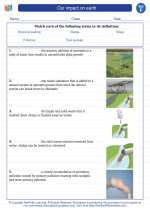Our impact on earth -> terrestrial ecosystems
Terrestrial Ecosystems
A terrestrial ecosystem is an area of land where living organisms interact with the physical environment. These ecosystems can be found in a variety of habitats, including forests, grasslands, deserts, and tundras. They are characterized by the types of plants and animals that inhabit them, as well as the climate and geography of the region.
Types of Terrestrial Ecosystems
There are several types of terrestrial ecosystems, each with its own unique characteristics:
- Forest Ecosystems: These ecosystems are dominated by trees and are found in both tropical and temperate regions. They are home to a wide variety of plant and animal species.
- Grassland Ecosystems: Grasslands are characterized by vast stretches of grasses and are home to grazing animals such as bison and antelope.
- Desert Ecosystems: Deserts are dry, arid regions with sparse vegetation and extreme temperature variations.
- Tundra Ecosystems: Tundras are cold, treeless regions found in the Arctic and high mountain ranges. They are characterized by low temperatures and permafrost.
Components of Terrestrial Ecosystems
Terrestrial ecosystems consist of both biotic and abiotic components:
- Biotic Components: These include all living organisms within the ecosystem, such as plants, animals, fungi, and microorganisms.
- Abiotic Components: These are the non-living factors that influence the ecosystem, including temperature, rainfall, soil, sunlight, and topography.
Interactions within Terrestrial Ecosystems
Within terrestrial ecosystems, there are various interactions between organisms and their environment:
- Food Chains and Webs: Organisms within the ecosystem are interconnected through feeding relationships, forming complex food chains and webs.
- Energy Flow: Energy from the sun is captured by plants through photosynthesis and then transferred through the ecosystem as organisms consume each other.
- Nutrient Cycling: Essential nutrients such as carbon, nitrogen, and phosphorus are recycled within the ecosystem through processes like decomposition and nutrient uptake by plants.
- Adaptations: Organisms within terrestrial ecosystems have evolved various adaptations to survive in their specific habitats, such as camouflage, hibernation, and water conservation mechanisms.
Human Impact on Terrestrial Ecosystems
Human activities, such as deforestation, urbanization, and pollution, have significantly impacted terrestrial ecosystems. It's important to understand the delicate balance within these ecosystems and the need for conservation efforts to protect them for future generations.
Study Guide
To study terrestrial ecosystems, you can focus on the following key areas:
- Identify and describe the characteristics of different terrestrial ecosystems, including their plant and animal species, climate, and geographical features.
- Explain the interactions between biotic and abiotic components within terrestrial ecosystems.
- Understand the concepts of food chains, energy flow, and nutrient cycling within these ecosystems.
- Discuss the impact of human activities on terrestrial ecosystems and the importance of conservation efforts.
By understanding the complexities of terrestrial ecosystems, we can appreciate the diversity of life on land and the interconnectedness of all living organisms within these habitats.
.◂Science Worksheets and Study Guides Sixth Grade. Our impact on earth
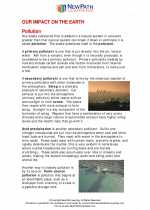
 Worksheet/Answer key
Worksheet/Answer key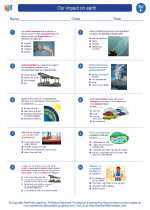
 Worksheet/Answer key
Worksheet/Answer key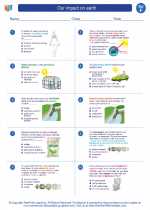
 Worksheet/Answer key
Worksheet/Answer key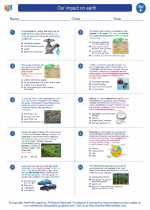
 Vocabulary/Answer key
Vocabulary/Answer key